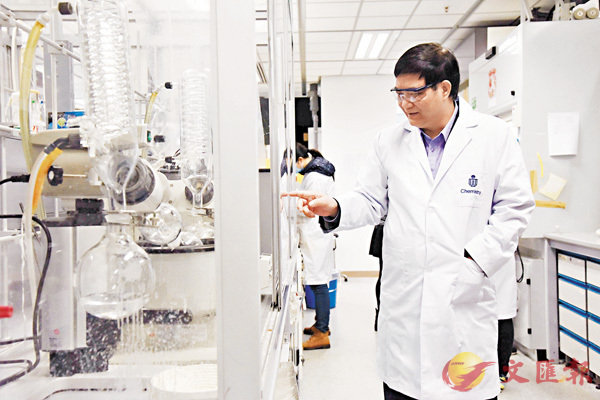 ■唐本忠及其研究團隊以「聚集誘導發光」項目榮獲「國家自然科學獎」一等獎。 資料圖片
■唐本忠及其研究團隊以「聚集誘導發光」項目榮獲「國家自然科學獎」一等獎。 資料圖片【原文】2017年度國家科學技術獎勵大會1月8日上午在北京人民大會堂隆重舉行,香港科學家唐本忠教授及其研究團隊,以「聚集誘導發光」項目榮獲「國家自然科學獎」一等獎。這是繼2006年香港大學化學系支志明教授之後,再次有香港科學家獲此殊榮。
唐本忠此次獲獎的「聚集誘導發光」(AIE)項目屬於首創(pioneering)的新概念,顛覆了發光材料(fluorescent materials)的傳統認識,更引發了對有機發光材料分子的設計、機理研究與實際應用的變革,可以廣泛應用在能源(energy)、環境和健康等領域。
目前,AIE研究已發展成為一個由我國科學家開創並引領、國外科學家競相跟進的熱點前沿領域。
增學研產互動 免技術「沉睡」
不過,香港在科研成果產業化(commercialisation)方面並不突出。政商界都要認真檢討原因,加強與高校的聯繫與合作,爭取將教授們的科研理論和技術成果轉化到商業應用領域。政府需增加資源(resources),多投入創科產業,成立促進成果轉化的專項基金,創建更多學研產之間的互動(interactive)平台,營造良好的環境,讓香港的科研能力變成經濟發展的新增長點(a new drive)。
由於多種原因,香港很多成功發明創造並沒有轉化為商業運用。例如,香港科學園某研究機構發明了一種讓羊毛衫不起毛(anti-pilling)的全新技術,國家領導人來港訪問時還專程參觀,給予高度讚揚。
該項目本應具龐大應用前景,但由於多種原因,有關技術還沒商業化(hit the market),新發明的專用設備在科學園裡沉睡了好幾年。
轉化成本高有兩原因
究其原因,第一是香港商界長期專注樓市(local property)等傳統「高回報」產業,沒有為科研成果產業化等新興產業(emerging industries)投入資源。
其次,特區政府在促進科研成果轉化為商業運用方面,重視不夠、辦法不多,尤其怯於「官商勾結(collusion)」等指責,不敢為科研成果的商業轉化提供切實支持。政府有關部門因而變得因循守舊,審批關卡重重,令許多科研成果轉化望而卻步;商界因此也擔憂難以承擔較高的轉化成本,因而令到很多科研成果只能停留在實驗室成果階段(remain in the laboratories)。
事實上,港人頭腦靈活、變通,具創意思維(innovative)又懂得做生意,只是大多數中小企業都難以支撐龐大的轉化成本(affordability)而已。
因此,應呼籲大企業要有長遠的眼光,更呼籲特區政府增加對科研轉化的投入,增撥資源建立更多專項的成果轉化基金和孵化資源,支持商家以較低的成本,把科研產品轉化為商業運用,在項目有利潤之後再與基金分成。 (標題及小標題為編輯所加) (摘錄自香港文匯報社評9-1-2018)
Boost commercialised R&D with more funds and resources
【譯文】The 2017 National Science and Technology Award Conference was held at the Great Hall of the People in Beijing on 8 January. The Hong Kong scientist Professor Ben-zhong Tang and his team received the First Class Prize of the State Natural Science Award for his aggregation-induced emission (AIE) project. Tang is the second Hong Kong scientist to receive this award, with the first being Professor Chi-ming Che, Chair of Chemistry at the University of Hong Kong, who received the same award back in 2006.
The award-winning AIE project is a pioneering concept that has subverted the traditional understanding of fluorescent materials. It has also inspired changes in the molecular design, mechanism research and practical application of organic light-emitting materials. Tang's work can be widely applied in various fields such as the energy sector, environmental protection and healthcare.
AIE researches have now attracted a lot of attention from the world, with China being the leader and pioneer in this field.
R&D could be new economic drive
However, commercialisation of research and development (R&D) results has not been given proper attention in Hong Kong at the moment. Both the public and private sectors should thoroughly review the root causes, start strengthening their communication and cooperation with tertiary institutions, and step up their efforts in finding commercial applications in researchers' theories and technological achievements.
Also, the government should inject more resources into the innovation and technology industry by setting up funding schemes that encourage the commercialisation of R&D achievements. By introducing more interactive platforms between the education sector, research and industry, a more favourable environment could be achieved. The enhanced research capability could then be a new drive for Hong Kong's economic development.
For multiple reasons, plenty of technological achievements that originated from Hong Kong were not commercialised in the end. For instance, a research institute in the Hong Kong Science Park had come up with an anti-pilling technology for woollen materials and was highly praised by a visiting state leader years ago. This groundbreaking technology had shown huge commercial promise, yet for some reasons it still has not hit the market, and its equipments are now left in the dust.
Two causes of slow progress
There are two reasons for our failure to capitalise on technological achievements. Firstly, the business sector has long been tunnel-visioning on industries that are traditionally conceived to have "high return". With their focus resting solely on markets such as local property, no investments were made to emerging industries such as commercialised R&D.
Secondly, the government has not given enough support and attention to promoting the commercialisation of R&D achievements. Out of fear for accusations of business-government collusion, the authorities remained reluctant and very bureaucratic in providing solid assistance. As a result, many attempts in commercialising R&D outcomes have been discouraged from seeking government support. This in turn deterred the private sector's participation, as the costs involved might increase. Subsequently, many of the technological achievements could only remain in the laboratories.
The people of Hong Kong are adaptable, innovative, and possess great entrepreneurship. The only barrier in the process of commercialising R&D results is its affordability to local SMEs. Therefore, the government and large enterprises should focus on the long-term and boost their investments in translational R&D works. Meanwhile, the authorities should also allocate more resources to set up funds that support businesses to commercialise research outcomes at a lower cost. Successful commercialisation attempts could then return the government's share of profit.■Jeffrey Tse [ywc_jeffrey@hotmail.com]
Learning Point
「聚集誘導發光(AIE)」現象於2001年由唐本忠及其團隊率先發現,他們研究出特定結構的發光分子,在聚集狀態中亦可高效發光,打破當時科學界普遍認為發光分子「聚集」就會令其光芒「熄滅」的定律(即「聚集淬滅發光」)。有關現象成為了突破點,為不同的應用範疇開拓了新的研究方向。

